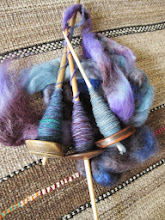When I came to Laos, I was hoping to see some cotton fiber
preparation and spinning. The Living Crafts Centre being what it is, it did not
take long to coordinate my interests with the needs of the centre. There is a
cotton display that required attention, and women from a major cotton producing
area were due in town. One of these women, Euay Navon*, came to demonstrate the
various steps of the process, and I got to simultaneously document and learn
from her.
Notice that she is beautifully dressed in all handspun,
handwoven cotton, in several different types of material.
The cotton, she said, was not the best quality, because it
hadn’t gotten enough sun to dry out after picking. She also showed how it can
get damaged by rain, if the water gets inside the pod as the cotton grows (left damaged, right good).
The bad parts have to be sorted out, then the
seeds can be removed with a hand-cranked gin (eeuw in Lao). This was so much easier and faster than other
seed-removing methods I’ve seen, such as the Ethiopian rolling of a stick
against a stone to squeeze away the seeds.
The ginned cotton is then fluffed up using a bow (kâ gong) inside a horizontal
barrel-shaped basket. This is similar, conceptually, to the bowing done in
India by men who go around and re-fluff the batting of quilts. Somehow, the
flicking of the bowstring teases the cotton apart, eventually making it into a
nice, fluffy cloud. Some technique is definitely involved, and my clouds are
not as fluffy as Euay Navon’s.
The cloud is separated into bits about the size of two handfuls,
placed on a smooth surface, and rolled around a stick to form a cylindrical puni or fai lor. These are made nice and firm,
tightly packed before the stick is removed.
Now we’re ready to spin on a wheel (lâ), or technically a wheel-driven spindle, just like the Indian
charka. The wheel is turned with the right hand while the cotton is spun long
draw against the quill with the left hand, as with a charka or a great wheel. Euay Navon makes relatively short
passes, not allowing the yarn to wind on too close to the quill before drafting
back again. She is a patient teacher, and emphasized the importance of pulling
quickly, straight back from the quill tip, with a slight vertical angle.
Trying this, I experienced that ‘leap of faith’ I’ve heard spinners talk about regarding long draw – at times, Euay Navon would pull my hand back for me, and it seemed so fast, and she’d make a cranking motion with her right hand, telling me to keep adding twist. That balance of speed and control is a delicate thing, and I only got it for brief moments before turning clumsy again.
The spun yarn is skeined on a niddy-noddy (piya), of which there is a beautiful
example here at the Living Crafts Centre. I didn’t find it in time to get Euay
Navon to demonstrate, but it has both sets of arms parallel, so they must wind
on straight. Will research further….
Much of the weaving is done with singles, such as Euay
Navon’s beautiful indigo plainweave shirt.
This was such a treat and a privilege, and now I practice my
newly learned techniques to make the cotton display informative and authentic.
Several of the silk weavers are also accustomed to working with cotton in their
home villages, and they took to the ginning and bowing as soon as it was put on
display. This is a good way to find out who has the knowledge: put the tools in
front of them, and they can’t resist showing their stuff.
* Euay is a respectful Lao term of address, literally meaning 'older sister', which Euay Navon is to me, by just a very few years.
A short video of this demonstration is on YouTube:













6 comments:
I watched the video and learned a lot. Bowing the cotton intrigues me and I have to try it. The cotton must be a slick seed type to gin that easily. Much different from the cotton we get here in the US.
Wow, Tracy. You must be learning so much, but there is so much more to learn. I've Pinned your picture of Euay Navon's shirt: such beautiful, honest fabric!
What a lovely post! The bow fluffing reminds me of my childhood at home in Calcutta. Men would come every six months or so to fluff up, and re-upholster our mattresses. It took a whole day of two men working on a number of mattresses. They even sang a song while working, the flicking of the bow string provided music for their song :).
Ah, those were the days...
Fascinating. I just bought me a charkha! Have only tried it for a few minutes (and stared at the box lovingly).
It is humbling to see all that can be accomplished with basic tools and no electricity. This is a beautiful post, thank you for sharing.
My passion is growing, spinning, and weaving cotton and I have been fascinated with bowing cotton. I haven't constructed a bow that works well, though, so I'd love to know more about your experience. Thank you so much for this post.
Post a Comment